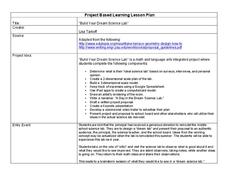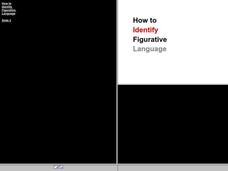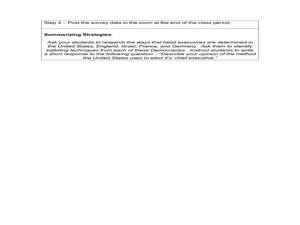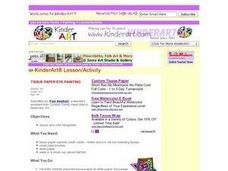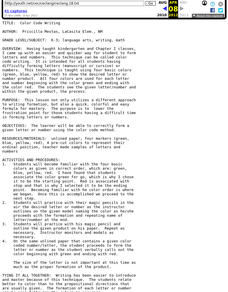EngageNY
Writing and Evaluating Expressions—Exponents
Bring your young mathematicians into the fold. Scholars conduct an activity folding paper to see the relationship between the number of folds and the number of resulting layers in the 23rd installment of a 36-part module. The results of...
Marilyn Burns Education Associates
Eighteen Flavors
Your learners will be tantalized by this inquiry-based, collaborative activity as they discover how to write an equation that represents the height of an ice cream cone. Given the scenario based on the poem, "Eighteen Flavors," and...
Curated OER
Build Your Dream Science Lab
Would your ideal science lab be filled with bubbling beakers and zapping Tesla coils? Or would it contain state-of-the-art computer technology and data analysis? Dream big with an innovative lesson that connects math and language arts...
Concord Consortium
In a Triangle
What's in a triangle? Just 180 degrees worth of angles! Young learners use given angle relationships in a triangle to write an algebraic representation. Using a system of equations, they simplify the equation to a linear representation.
Curated OER
Using Graphology to Teach Traditional Writing
Introduce your class to the narrative, descriptive and expository forms of writing. In groups, they discuss the personality of the author while graphing the characteristics after reading different examples from the same writer. To end...
CCSS Math Activities
Smarter Balanced Sample Items: 7th Grade Math – Target D
Put expressions, equations, and inequalities to work! Young scholars solve problems using various strategies. Meant as a snapshot of the Smarter Balanced Assessment, a set of seven questions includes topics from writing expressions to...
Curated OER
How To Identify Figurative Language
Students investigate writing techniques by analyzing a chart. In this figurative language lesson, students define similes, metaphors and identify the difference between them and personification. Students demonstrate their understanding...
Curated OER
Reading, Writing, and Math in Daily Living
Learners use reading, math, and writing skills to complete this activity in which they make chocolate chip cookies. This lesson seeks to tie real-life skills to classroom learning to make curriculum more meaningful. While this activity...
K20 LEARN
Chicken Truck: Writing Algebraic Expressions
How did the chicken travel down the road? Given a picture of a chicken truck, class members brainstorm what information they need to determine the total number of chickens on the truck. Pupils research for the information and devise a...
Berkshire Museum
Adopt a Schoolyard Tree
Help young scientists connect with nature and learn about trees with a fun life science lesson. Heading out into the school yard, children choose a tree to adopt, taking measurements, writing descriptions, and drawing sketches of it in...
Concord Consortium
Line of Sight
There's no way around it—learners must use trigonometry to model the line of sight around a race track! Using the starting line as the origin, pupils model the straight line distance to any car using a trigonometric expression. The...
Curated OER
Chocolate Preferences Voting and Graphing Techniques
Students practice sampling and graphing techniques. In this data collection and interpretation lesson plan, students write and conduct surveys about chocolate preferences and then collect their data. Students graph the data in order to...
EngageNY
Two-Step Problems—All Operations
Step 1: Use the resource. Step 2: Watch your class become experts in solving two-step problems. Scholars learn to solve two-step word problems in context. They use tape diagrams and algebraic techniques to break the problem into two,...
Mathed Up!
Proof
Scholars learn how to write number theory proofs by viewing a video reviewing techniques for proofs on divisibility, parity, and consecutive integers. They then write proofs for a handful of conjectures on a worksheet.
Willow Tree
Problem Solving
School subjects connect when your young scholars use math to edit English. Math allows you to convert an entire paragraph into a simple equation or inequality. Examples encourage learners to write expressions, equations, and inequalities...
Curriculum Corner
Guest Teacher Plans: Grade 3
Always be prepared for a substitute teacher with a daily plan equipped with an assortment of activities that cover third grade math, reading, word work, and writing.
Kent State University
How Does that Work?
Sixth and seventh graders explore algebra word problems. They work with a partner to solve word problems distributed by e-mail. Learners simplify mathematical expressions following a "think aloud" algebra strategy modeled by the teacher....
Concord Consortium
It's In the Mail
It's time to check the mail! The task is to determine the most cost-effective way to mail a packet of information. Young scholars write an equation that models the amount of postage as a function of the number of sheets mailed and...
Curated OER
Narrow Corridor
Buying a new sofa? Learn how to use the Pythagorean Theorem, as well as algebra and graphing techniques, to determine whether the sofa will fit around a corner (which I'm sure you'll agree is a very important consideration!).
CK-12 Foundation
Inverse Variation Models: Speedometer for Inverse Variation Models
Model inverse variation while solving a real-world problem. Young scholars use the interactive lesson to discover the pattern of inverse variation data. They then use that discovery to write and analyze an equation.
Curated OER
Tissue Paper Dye Painting
Use tissue paper squares to create collage art. Young artists discuss colors as they place and glue each piece of tissue on the paper. Tip: Cut out large basic shapes instead. Have the class create images using the tissue shapes (robots...
Flipped Math
Factor Trinomials by Grouping
Help! The leading coefficient is not one. Learners view a video showing a technique to factor trinomials when the leading coefficient is not one. Pupils try a few examples including solving equations by factoring and check their answers...
Curated OER
Color Code Writing
Young scholars form letters and numbers using a technique called color code writing.
Curated OER
Adjective Monster
Explore descriptive writing and visual art. Listen to the story Go Away Big, Green Monster by Ed Emberley and generate a list of adjectives used in the book. Name familiar shapes and create a shapes list. Choose an adjective and shape to...
Other popular searches
- Writing Technique Persuasive
- Timed Writing Technique
- Review Writing Technique
- Analyze Writing Technique
- Writing Technique Gt
- Evaluate Writing Technique
- Nonfiction Writing Technique
- Writing Technique Clerical
- Writing Technique Rubric
- Writing Technique Writing Type
- Writing Technique Closing
- Writing Technique + Closing




